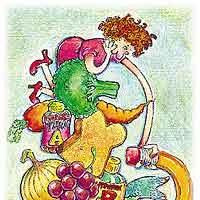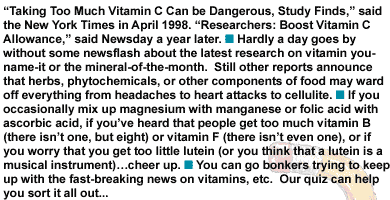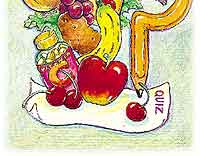| Answer |
| 1. | c. prostate cancer
Women who could become pregnant should take a multivitamin with 400
mcg, the Daily Value for folate. That amount helps prevent neural tube
birth defects. Though more studies are needed, the same level also
appears to cut the risk of heart disease, stroke, and colon cancer. [back]
|
| Answer |
| 2. | e. a vitamin supplement
In younger people, all but the vegetables would be a good source of
B-12 (which is only found in animal foods). But if you’re over 55, your
stomach might not produce enough acid to extract the B-12 from food. To
play it safe, take a daily dose of 25 mcg, the amount in many
supplements for seniors. [back]
|
| Answer |
| 3. | b. excessive thirst
Vitamin B-12 deficiency can cause irreversible nerve damage. If you
have any of the symptoms (other than excessive thirst), get your B-12
blood levels checked. Anemia can also be a sign of B-12 deficiency, but
you can get nerve damage without anemia. (Excessive thirst could be a
sign of diabetes.) [back]
|
| Answer |
| 4. | d. pyridoxine (B-6)
The B-vitamins—like other water-soluble nutrients—are usually safe at
high doses. B-6 is the exception. The Tolerable Upper Intake Level (UL)
was set at 100 mg because higher daily doses can cause a (reversible)
nerve toxicity that leads to difficulty walking, clumsiness, numbness,
or burning, shooting, or tingling pains. The Daily Value for B-6 is
only 2 mg. [back]
|
| Answer |
| 5. | a. vitamin B-2
People who consume more vitamin B-6 (about 4.6 mg a day), folate (at
least 400 mcg a day), or vitamin E (at least 100 IU a day) have a lower
risk of heart attacks. Vitamin B-6 and folate may protect the heart by
lowering blood levels of homocysteine. None of the research is
definitive, though. Clear answers about vitamin E may come from
clinical trials that are under way to see if it can prevent heart
attacks. [back]
|
| Answer |
| 6. | c. colon cancer
In a study of people who already had precancerous colon polyps, taking
1,200 mg of calcium a day cut the risk of new polyps by 24 percent.
However, preliminary
evidence suggests that men who consumed 2,000 mg of calcium a day—from
food or supplements—had a higher risk of prostate cancer than men who
consumed lower levels. Until we know more, men shouldn’t assume that
more calcium is better. [back]
|
| Answer |
| 7. | d. five cups of cooked broccoli
Each cup of cooked broccoli has 70 mg of calcium, so you’d need 17 cups
to get a day’s worth of calcium (not that you need to get all your
calcium from a single food). Collards (with 230 mg per cup) and cooked
frozen kale (with 180 mg per cup) are richer sources. [back]
|
| Answer |
| 8. | b. 2,500 mg
In 1997, the National Academy of Sciences set an Upper Tolerable Intake
Level (UL) for calcium of 2,500 mg a day. Too much calcium can cause
kidney stones, high blood calcium, or impaired absorption of iron,
zinc, or magnesium. But 2,500 mg a day isn’t a target. Shoot for 1,000
mg a day if you’re 19 to 50 and 1,200 mg a day if you’re older than 50.
[back]
|
| Answer |
| 9. | a. high blood pressure
In a recent study in Boston, half of the women with hip fractures were
deficient in vitamin D. So far, only one study has found slower
progression of arthritis in people with low D levels. [back]
|
| Answer |
| 10. | b. a highly fortified cereal like Product 19 or Total
Milk—not other dairy products—is one of the few good sources of vitamin
D. Even cereals with 100 percent of the Daily Value for other vitamins
and minerals don’t supply much D. Experts recommend 200 IU a day if
you’re 19 to 50, 400 IU a day if you’re 51 to 70, and 600 IU a day if
you’re older than 70. As people age, their skin gets less efficient at
making vitamin D when exposed to the sun. You can’t get enough vitamin
D from the sun in the winter unless you live in the Southern U.S. [back]
|
| Answer |
| 11. | c. getting enough vitamin E
Avoiding overweight and limiting alcohol (to no more than one drink a
day for women; two for men) also keep blood pressure from rising. [back]
|
| Answer |
| 12. | d. rye bread
Fruits and vegetables, especially beans (except green beans), are the
best sources. Whole grains have more than their refined cousins (almost
all rye breads are refined), but even whole- wheat bread isn’t loaded
with potassium. Bran cereals are a better source. Most
multivitamin-and-mineral supplements and fortified breakfast cereals
don’t supply much potassium. [back]
|
| Answer |
| 13. | a. memory loss
Too little
iron can impair memory and learning in adolescent girls (iron
deficiency is less common in boys). But too much may raise the risk of
cancer and heart disease. About one in 250 Americans has the genes for
iron overload, or hemochromatosis, which can damage the liver, heart,
brain, pancreas, and other organs. To play it safe, get your blood
ferritin checked.
If you’re male or postmenopausal, look for a multivitamin that supplies no more than 10 mg of iron a day.
The 18 mg in most multis is the recommended allowance for teenage boys. [back]
|
| Answer |
| 14. | d. eating enough potassium
It’s clear that extra pounds raise the risk of diabetes. Exercise
lowers the risk, even if you’re not overweight. The evidence for
fiber-rich foods and magnesium, while promising, is shakier. [back]
|
| Answer |
| 15. | a. magnesium
In separate clinical trials, men who took 200 mcg of selenium or 50 IU
of vitamin E every day had a lower risk of prostate cancer. Studies are
under way to duplicate those results. There are no trials on lycopene
or red meat. However, men who eat less red meat—and less animal
fat—seem to have a lower risk. Ditto for men who have higher blood
levels of lycopene or who eat more lycopene-rich tomato-containing
foods, especially cooked foods like tomato sauce. [back]
|
| Answer |
| 16. | d. almonds
Almonds are the best of the bunch, with 11 IU in three tablespoons. But
only supplements have the amounts that may help reduce the risk of
heart disease (100 IU a day) or prostate cancer (50 IU a day). [back]
|
| Answer |
| 17. | c. zinc
Zinc can impair the immune system at daily doses as low as 50 mg (in
addition to the 15 mg in a typical diet). Vitamin A can cause liver
damage and possibly birth defects at daily doses of 10,000 IU or more.
Vitamin B-6 can cause (reversible) nerve damage at doses of 200 mg or
more. [back]
|
| Answer |
| 18. | b. 200 mg
The current Daily Value is 60 mg, but some vitamin-C experts think that
intakes should be at least 100 mg or, more likely, 200 mg.
If you eat the eight to ten servings of fruits and
vegetables a day that we recommend, you should get at least 200 mg. So
far there is no Upper Tolerable Intake Level (UL) for vitamin C. It
should be 1,000 mg a day, some argue, because more than that may raise
the risk of kidney stones. [back]
|
| Answer |
| 19. | c. vitamin E
Most people know that calcium and vitamin D are crucial for strong
bones. But it’s also important to get enough vitamin K. Women should
shoot for 65 mcg a day, while men need 80 mcg.
Green leafy vegetables are the best source. Most people get sufficient fluoride from fluoridated water. [back]
|
| Answer |
| 20. | c. zinc
There is no good way to test for zinc deficiency. Instead, researchers
give people more zinc and see if it improves the symptoms of a
deficiency—diminished taste, wounds that take long to heal, or
recurring infections that don’t clear up easily. As for the other
nutrients, it’s worth getting your blood tested for 25-hydroxyvitamin
D, serum ferritin (to see if you get too little or too much iron), and
vitamin B-12. [back]
|
| Answer |
| 21. | d. a supplement
Seafood is the most reliable food source of selenium. The selenium
content of other foods varies depending on where they were grown. If
you want to get 200 mcg a day—the amount that may cut the risk of
cancer—the safest way is to take a supplement. [back]
|
| Answer |
| 22. | a. colon cancer
As little as 10,000 IU a day of vitamin A may raise the risk of birth
defects when taken by pregnant women and may cause liver damage when
taken by older people for 10 to 15 years. Beta-carotene doesn’t cause
birth defects or liver damage, but two studies found an increased risk
of lung cancer in smokers who took 33,000 IU to 50,000 IU (20 mg to 30
mg) of beta-carotene a day for several years. In contrast,
beta-carotene-rich foods, like carrots, sweet potatoes, and cantaloupe,
are linked to a lower risk of lung cancer. [back]
|
| Answer |
| 23. | d. vitamin E
When sedentary older people were told to exercise for 45 minutes a day,
those who were given vitamin E had fewer signs of muscle damage than
those who took a placebo. The study used 800 IU a day, but as little as
200 IU to 400 IU may be sufficient. [back]
|
| Answer |
| 24. | b. cantaloupe
Most fruits are not especially rich in magnesium. Nor are most
vegetables, except for leafy greens and dry beans. Whole (not refined)
grains and milk or yogurt can help you reach 320 mg (women) or 420 mg
(men) a day. Most multivitamin-and-mineral supplements and fortified
breakfast cereals supply only about 100 mg per serving. [back]
|
| Answer |
| 25. | a. collard greens
Studies suggest that foods rich in lutein, a carotenoid found in green
leafy vegetables, may help prevent macular degeneration, the most
common cause of blindness in older people. (The macula is the center of
the retina.) [back]
|
| Answer |
| 26. | c. saw palmetto
There is consistent evidence that a daily dose of 320 mg of saw
palmetto can help men with benign prostatic hypertrophy (enlarged
prostates). The evidence for the others is inconclusive. [back]
|
| Answer |
| 27. | d. ginseng
Glucosamine seems to curb arthritis pain, St. John’s wort appears to
help one out of two people with clinical depression (whether it “cures
the blues” for people who aren’t clinically depressed is untested), and
kava kava may help people with clinical anxiety (it’s less certain
whether it “relieves daily stress” or helps you relax). So far, there
is insufficient evidence that ginseng is good for memory, energy,
sexual interest or potency, symptoms of menopause, or the immune
system. [back]
|
| Answer |
| 28. | a. cod
In some studies, people who consumed about 1.5 grams of omega-3 fats a
week had a lower risk of heart attacks. You can get that much in six
ounces of cooked (eight ounces of raw) salmon or rainbow trout or three
ounces of canned sardines.
A six-ounce serving of most other fish, including
cod, flounder, tuna, clams, catfish, haddock, perch, and halibut, has
between 0.2 and 0.9 grams of omega-3 fats. [back]
|
| Answer |
| 29. | d. chondroitin
Experts are concerned that DHEA may raise testosterone levels, which
may increase the risk of prostate cancer. Ephedra has been linked to
about three dozen deaths and more than a thousand adverse reactions.
And a half dozen samples of 5-HTP tested by the FDA contained a
contaminant like the one that caused eosinophilia myalgia—a painful and
sometimes disabling muscle disorder—in people who took tainted
tryptophan supplements in the late 1980s. [back]
|
| Answer |
| 30. | b. phosphatidyl serine
So far, the evidence is strongest that phosphatidyl serine (PS) can
boost memory in healthy people with greater-than-normal, age-related
losses. [back]
|





